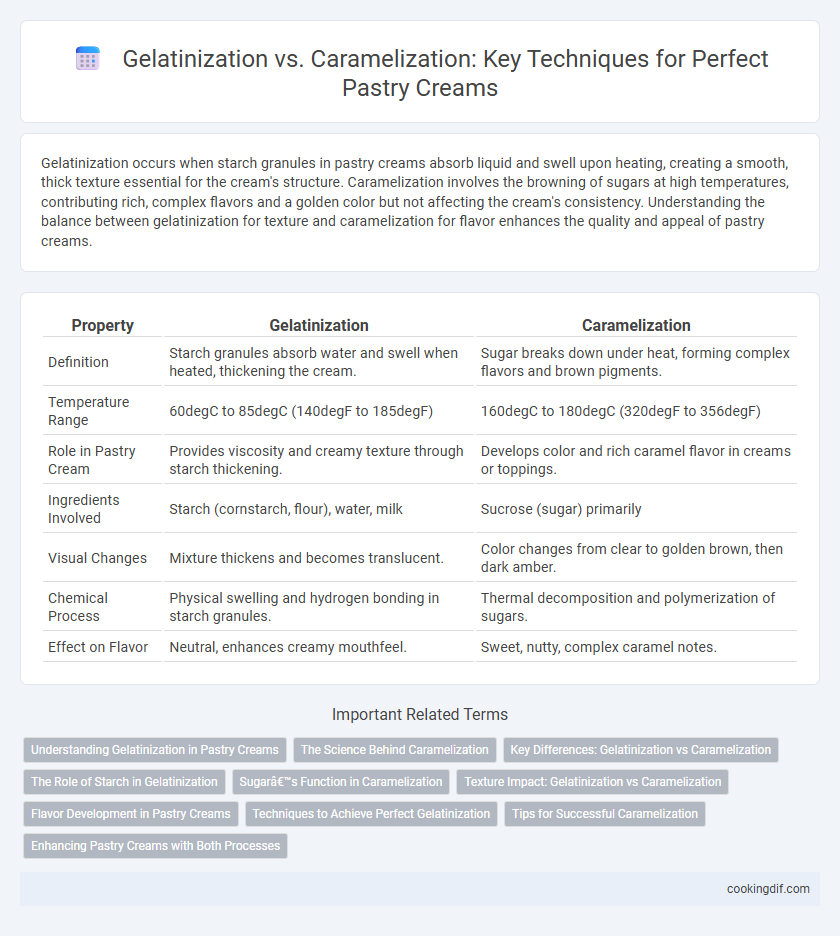Gelatinization occurs when starch granules in pastry creams absorb liquid and swell upon heating, creating a smooth, thick texture essential for the cream's structure. Caramelization involves the browning of sugars at high temperatures, contributing rich, complex flavors and a golden color but not affecting the cream's consistency. Understanding the balance between gelatinization for texture and caramelization for flavor enhances the quality and appeal of pastry creams.
Table of Comparison
| Property | Gelatinization | Caramelization |
|---|---|---|
| Definition | Starch granules absorb water and swell when heated, thickening the cream. | Sugar breaks down under heat, forming complex flavors and brown pigments. |
| Temperature Range | 60degC to 85degC (140degF to 185degF) | 160degC to 180degC (320degF to 356degF) |
| Role in Pastry Cream | Provides viscosity and creamy texture through starch thickening. | Develops color and rich caramel flavor in creams or toppings. |
| Ingredients Involved | Starch (cornstarch, flour), water, milk | Sucrose (sugar) primarily |
| Visual Changes | Mixture thickens and becomes translucent. | Color changes from clear to golden brown, then dark amber. |
| Chemical Process | Physical swelling and hydrogen bonding in starch granules. | Thermal decomposition and polymerization of sugars. |
| Effect on Flavor | Neutral, enhances creamy mouthfeel. | Sweet, nutty, complex caramel notes. |
Understanding Gelatinization in Pastry Creams
Gelatinization in pastry creams occurs when starch granules absorb heat and moisture, causing them to swell and thicken the mixture, providing the creamy, stable texture essential for fillings and custards. This process typically begins at temperatures around 140degF (60degC) and continues until the mixture reaches a smooth, velvety consistency without any graininess. Unlike caramelization, which involves sugar browning at higher temperatures, gelatinization is crucial for achieving the ideal structure and mouthfeel in pastry creams.
The Science Behind Caramelization
Caramelization in pastry creams involves the slow heating of sugars above 320degF (160degC), causing complex chemical reactions that break down sugar molecules into rich brown compounds, enhancing flavor and color. Unlike gelatinization, which thickens cream through starch swelling, caramelization transforms sugar's molecular structure, producing nutty, toasty, and bittersweet notes essential for depth in desserts. This Maillard reaction-free process is crucial for achieving the signature golden hue and intense flavor in caramel-infused pastry creams.
Key Differences: Gelatinization vs Caramelization
Gelatinization occurs when starch granules absorb water and swell upon heating, thickening pastry creams and providing a smooth, creamy texture essential for stability. Caramelization involves the thermal decomposition of sugars at high temperatures, resulting in a complex, rich flavor profile and a golden-brown color critical for enhancing the taste and appearance of pastries. Understanding the distinct temperature ranges--gelatinization typically begins around 60-70degC, while caramelization starts above 160degC--ensures precise control over texture and flavor development in pastry cream preparation.
The Role of Starch in Gelatinization
Starch plays a crucial role in the gelatinization process of pastry creams by absorbing water and swelling when heated, which thickens the mixture and provides its smooth texture. During gelatinization, starch granules disrupt and release amylose and amylopectin, forming a gel network essential for the cream's stability and consistency. Unlike caramelization, which involves sugar browning at high temperatures, gelatinization focuses on starch's transformation to create the desired creamy structure in pastries.
Sugar’s Function in Caramelization
Sugar's function in caramelization involves the thermal decomposition and browning of sucrose, enhancing flavor complexity and color depth in pastry creams. During caramelization, sugar molecules break down and form new compounds such as caramelan, caramelene, and caramelin, contributing rich, nutty, and buttery notes. This process differs from gelatinization, which primarily involves starch granule swelling and thickening, focusing on texture rather than flavor development.
Texture Impact: Gelatinization vs Caramelization
Gelatinization in pastry creams occurs when starch granules absorb water and swell upon heating, resulting in a smooth and creamy texture essential for stability and mouthfeel. Caramelization, the thermal decomposition of sugars, imparts a richer color and complex flavor but can lead to a thicker, sometimes grainy texture if overcooked. Balancing gelatinization and caramelization is critical to achieving a custard-like cream with optimal viscosity and a harmonious blend of sweetness and depth.
Flavor Development in Pastry Creams
Gelatinization in pastry creams enhances texture by thickening through starch granules absorbing liquid, creating a smooth and creamy mouthfeel essential for consistency. Caramelization generates complex flavor compounds by heating sugars, imparting rich, nutty, and slightly bitter notes that deepen the overall taste profile. Balancing gelatinization's texture development with caramelization's flavor intensification results in pastry creams that are both luscious and flavorful, elevating the sensory experience.
Techniques to Achieve Perfect Gelatinization
Achieving perfect gelatinization in pastry creams requires precise control of temperature, typically between 160degF and 180degF, to activate starch molecules without causing lumps. Constant whisking during heating ensures even heat distribution and prevents premature thickening or burning, while gradual incorporation of hot liquid into the starch mixture enhances smooth texture. Avoiding high heat that triggers caramelization preserves the cream's delicate flavor and consistent viscosity essential for classic pastry applications.
Tips for Successful Caramelization
Achieving perfect caramelization in pastry creams requires controlling temperature precisely, with ideal caramelization occurring between 320degF and 350degF to develop rich, complex flavors without burning. Use a heavy-bottomed pan for even heat distribution and continuously stir to prevent scorching and ensure uniform color. Incorporate a small amount of acid, such as lemon juice or cream of tartar, to stabilize sugars and enhance the smoothness and glossiness of the caramelized pastry cream.
Enhancing Pastry Creams with Both Processes
Gelatinization in pastry creams occurs when starch granules absorb water and swell upon heating, creating a smooth, thick texture essential for stability and creaminess. Caramelization involves the browning of sugars at high temperatures, adding rich, complex flavors and a subtle golden color to the cream. Combining gelatinization for texture and caramelization for flavor enhances pastry creams by delivering both luscious consistency and depth of taste.
Gelatinization vs Caramelization for pastry creams Infographic

 cookingdif.com
cookingdif.com